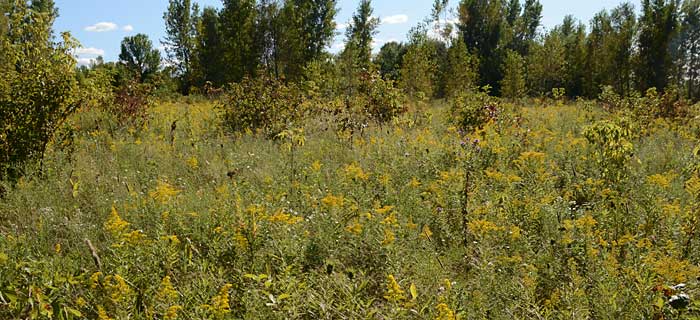Succession Plots

This part of the Cofrin Arboretum has been set aside as a demonstration of secondary succession, which begins after a disturbance such as logging, fire, or cultivation. Pre-settlement forests in this vicinity were cleared for agriculture nearly a century ago and farmed until the 1980's. Beginning in 1984, ½ acre plots in the farm field previously in front of this sign were systematically removed from cultivation. During each successive year until 1991, an additional ½ acre plot was set aside; since then, plots have been established at two year intervals. In 2001, the field consisted of 13 experimental plots ranging in age from 2 to 17 years of natural succession. The original project was planned to last 20 years, but that has been extended. Beginning in 2003, as space became limited, the schedule was changed so that a new plot was created every other year.
Plant succession in these fields has not followed a simple, easily recognized pattern. Factors such as annual climatic variations, proximity to seed sources, and movements of seed-dispersers like birds and mammals play a significant role in the succession process. These succession plots continue to provide a rich source of research opportunities for UW-Green Bay students and others interested in learning about ecological processes. Ecological succession is a natural process by which plants and animals at a site are replaced progressively by other species. During this process the physical conditions (soil moisture, shade, etc.) and species composition are modified until a self-perpetuating climax community becomes established or until a disturbance occurs.
The first plants during early stages of secondary succession are familiar garden weeds like Lamb's Quarters (Chenopodium album), Ragweed (Ambrosia artemisiifolia), and Foxtail Grass (Setaria glauca). After a few years these “pioneers” are replaced by perennial grasses Bluegrass (Poa pratensis), Quack grass (Agropyron repens), Smooth Brome (Bromus inermis) and forbs such as Goldenrods (Solidago canadensis, S. graminifolia) and Asters (Aster novae-angliae, A. ericoides). Shrubs and seedlings of pioneer trees like Box Elder (Acer negundo), Cottonwood (Populus deltoides), and Quaking Aspen (Populus tremuloides) eventually become established. These, in turn, are replaced by more competitive species of trees, and eventually the shade tolerant trees of our region's climax forests predominate. In the Green Bay region, the typical climax community consists of mixed conifer-deciduous forest dominated by shade-tolerant trees such as Sugar Maple (Acer saccharum), American Beech (Fagus grandiflora), Eastern Hemlock (Tsuga canadensis) and Yellow Birch (Betula alleghaniensis).